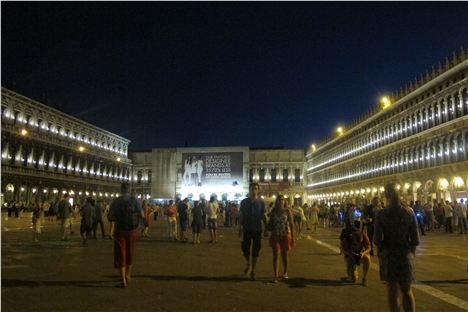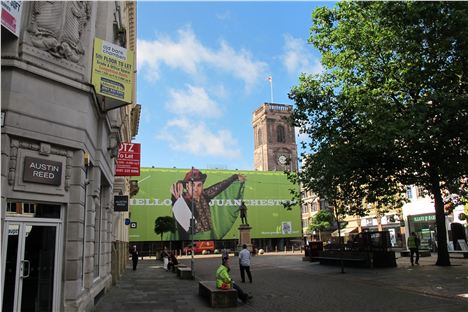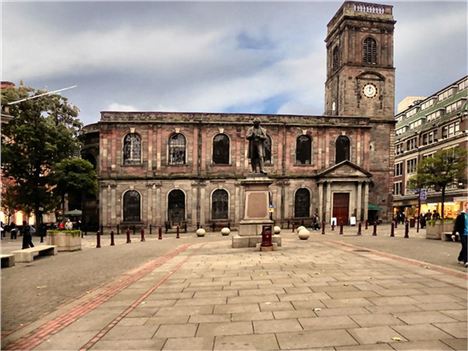Category: Ugly but understandable - for a a little while at least. But the church will have to re-appear soon.
What are we talking about?
St Ann's Church's incredible vanishing act. Or how to allow a Grade One listed church to be soaked up by a kitchen towel.
Kitchen towels?
Well, for three centuries St Ann's was in plain sight but recently it's disappeared first behind a mobile phone ad and now behind Juanchester. The latter is a big Nicholas Cage-like Mexican bandito figure of which I know little. He's advertising Plenty kitchen towels. No idea why - maybe all those murderous Mexican gangs of which we hear so much soak up the blood of the victims with Plenty towels. It's not a nice imposition on the old building.
It looks big
It's vast. At least a tennis court in size, maybe bigger. Certainly big enough to cover almost the whole north wall of the two story nave of the church. At the west end you can see the tower, there's a glimpse of apse to the east too, but everything else has all gone green. The north side is the most important side of the church in terms of cityscape facing the square. It's like God's been swallowed by JuanMammon.
Give a bit of background on the church
This is from our Best of series on Manchester Buildings - click here. 'St Ann’s Church is a handsome, Classically inspired building consecrated in 1712 and probably designed by John Barker. The interior is as cool as the exterior is elegant, with galleries squatting on chubby Tuscan columns. There is some fabulously over-wrought 19th century stained glass from artist Frederick Shields - look for the sinister and tiny devilish wolf in the central window. The church was restored by the famous Alfred Waterhouse, the Town Hall architect in 1887-91.The church is built from the local pinkish red sandstone, a material that crumbled badly under the pollution of the early industrial age, hence its rarity in the buildings of the city centre. The tower has recently been splendidly restored. The dedication refers to the saint, of course, but perhaps more so to the lady who provided the money, Lady Ann Bland. Out of the 19 city churches built in the 18th century, St Ann’s is the only survivor. The church tower is the traditional centre of the city. On the left near the tower door is the arrow-like surveyor's mark signifying this.'
So how come the big ad was allowed?
Part of the church was undergoing a welcome restoration, check our article here. It was going to be shrouded in scaffolding anyway. Given the highly visible site, the Church of England and the City agreed that it would be sensible to allow the scaffolding to be used as a billboard to help boost funds for St Ann's. Permission has now been extended to keep the scaffolding up until the end of September even though the present phase of repairs has been completed.
So at the end of September it comes down?
Apparently yes. Juanchester will fall. Although when further funds are raised the east end of the church will need looking at, maybe there'll be room for an ad or two there.
But should it have been permitted at all? This is one of Manchester's best public areas, the church one of Manchester's special buildings
Well given the cost of maintaining old buildings - the present refurb has cost £700k - and the fact that there would have been scaffolding masking the building anyway then there was a case for allowing advertising. If you couldn't see the buidling anyway why not utilise the earning potential? Of course a sponsored representation or diagram of what the building behind the scaffolding looks like might have been better. This is a popular solution on the Continent, not that all cities have pursued this route...
 St Mark'sName a city that hasn't
St Mark'sName a city that hasn't
Faced with utterly crippling bills to stop its heritage falling apart and with government financial support decreasing, Venice has very publically gone down the advertising route. One of the most famous spaces in the world, St Mark's Square, presently sports a vast McArthur Glen shopping centre advert, while round the corner Lacoste dominates part of the Grand Canal. In answering critics Renata Codello, the government's Venetian heritage administrator, said the budget was 25% down. "If the geniuses who criticise us give me the money for the restorations, I'll do away with [them] at once," she said. The mayor of Venice in taking the decision to allow celebrated views to be altered put it firmly but simply: "It's not beautiful, it's not ugly, it's necessary". The Rector of St Ann's, Nigel Ashworth, said something similar to me, "It's not ideal but it's an opportunity to raise funds to ensure the church has another three hundred years."
 Venice: McArthur Glen ad in St Mark's
Venice: McArthur Glen ad in St Mark's
But they are ugly, aren't they?
Yep. If you look at aesthetically St Mark's needs to studied as an architectural ensemble, not as a backdrop for a brand. If there were an end in sight for the advertising then Venice might have an excuse for erecting them - although the council must have been at its wit's end to approve the scheme. Of course Manchester doesn't quite have the problems of Venice so you've got to have sympathy for La Serenissima. We're lucky therefore that Juanchester's only got a limited run. But St Ann's is part of a trend in Manchester, Central Library had its car advertisements for example. The precedent has been set.
What do you mean?
You just know that the next major heritage landmark of Manchester to be cleaned and repaired will be swathed in advertising. Let's just hope the choice of advertisement is a little more subtle that the silly Plenty one, the previous Samsung ad, largely white, was much more discrete. Still as pointed out above it's probably the right thing to do if it's only for a limited duration. Money talks and money saves. Like Jesus. Except in this case with bricks and mortar rather than souls.
If you liked this article you'll probably like this one about Dial House.
















